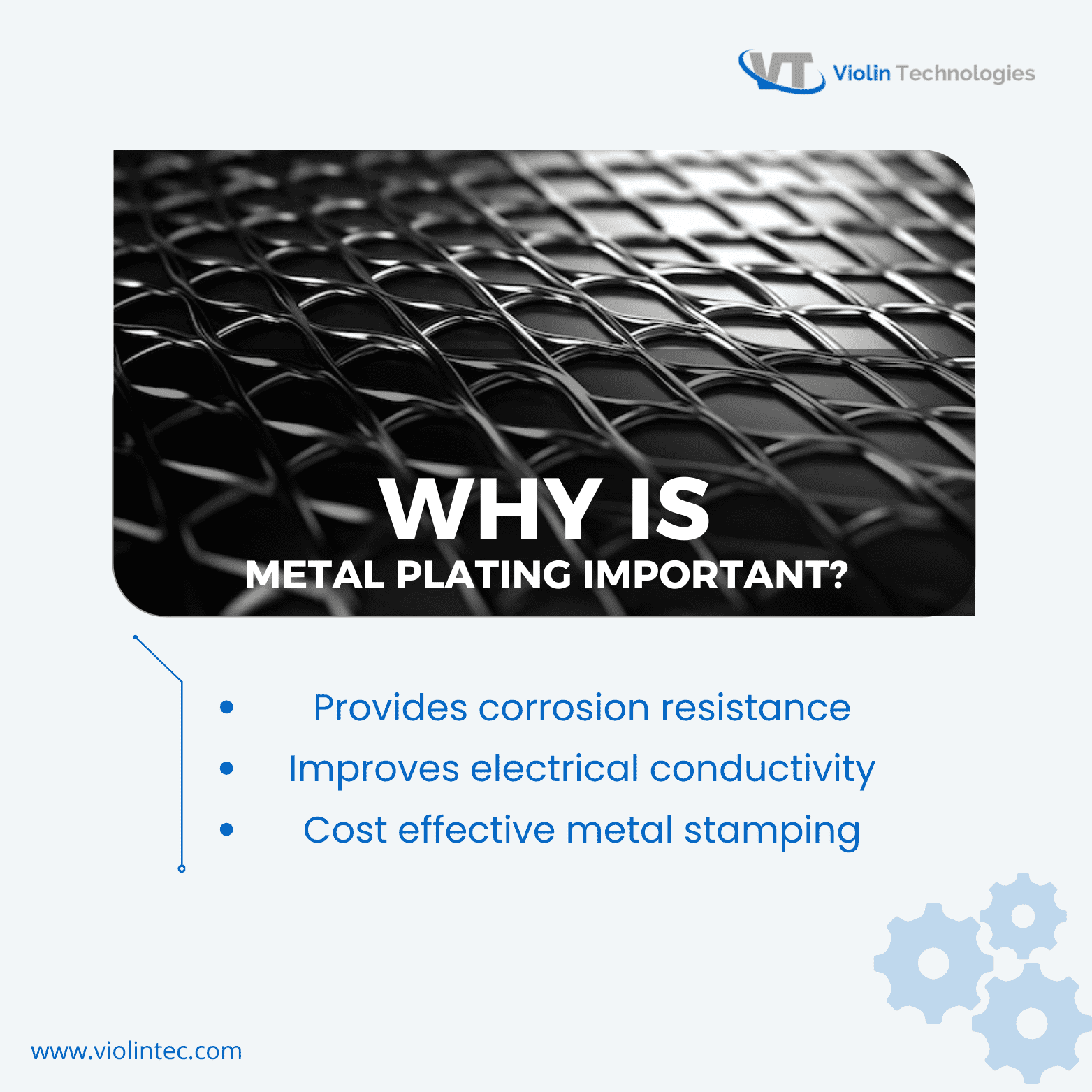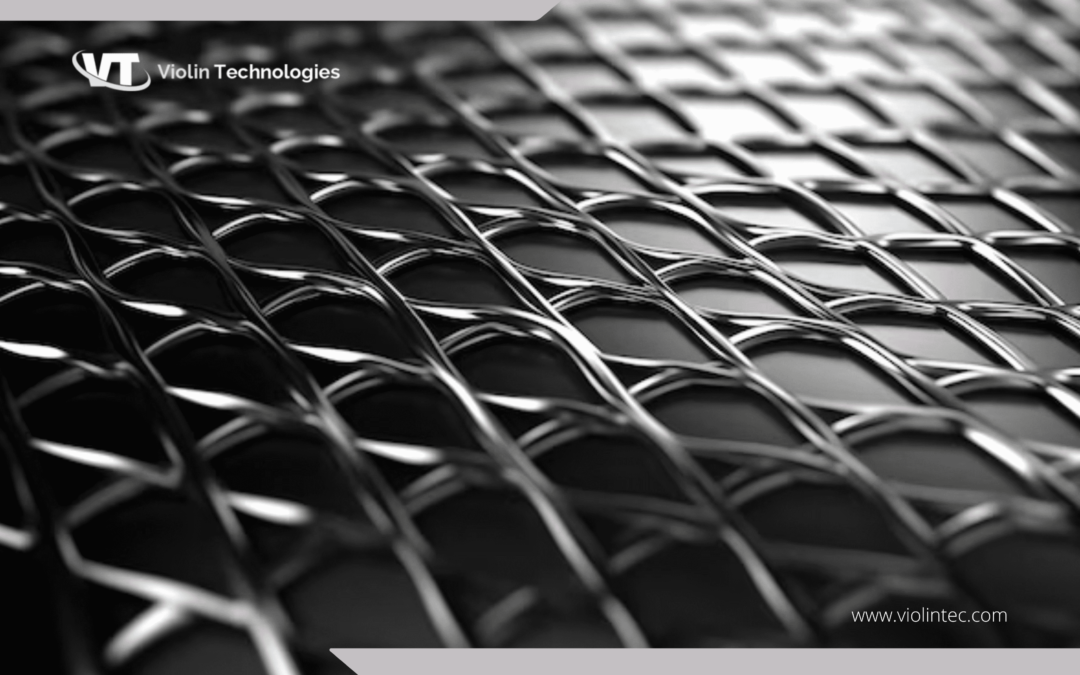What we cover in this blog?
Key Takeaways
- Metal plating enhances stamped parts for optimal performance and longevity.
- Plating ensures high corrosion resistance and conductivity in components.
- Improved appearance and durability of stamped parts minimize waste and costs.
- Metal plating is essential for cost-efficient and durable stamped parts.
Why Is Metal Plating Important?
1. Provides Corrosion Resistance
The primary reason for metal plating is to provide resistance to corrosion to the sheet metal stamped parts. Plating materials like aluminum chromatin, zinc, and zinc-nickel create a protective barrier, extending the lifespan of these parts. Additionally, a corrosion-resistant plating material improves the appearance of metal parts by preventing stains, surface discoloration, and rust.
These are applied in the automotive industry as corrosion-resistant plating is important for automotive components exposed to moisture, road salts, and environmental pollution.
2. Improves Electrical Conductivity
Metal plating also improves the electrical conductivity of stamped parts, which is important for components used in electrical connections or electronic devices, where reliable conductivity is necessary for optimal performance.
Plating materials such as gold, silver, nickel, and copper are known for their high electrical conductivity. Manufacturers can optimize electrical performance by selectively plating these materials onto the contact surfaces or conductive paths of stamped parts.
Plating also reduces oxidation and acts as a protective barrier, thereby maintaining consistent conductivity.
OEM engineers can utilize the expertise of sheet metal and stamped parts suppliers to produce high-quality stamped metal that offers high electrical conductivity and overall high efficiency.
3. Cost Effective Metal stamping
Metal plating is an important consideration when creating cost-effective stamping components. While metal stamping requires plating to improve material performance, plating also ensures component quality for strong corrosion resistance and conductivity via various metals. It improves the look and durability of stamped components, resulting in less material waste and lower production costs.

Metal Plating Processes
Electroplating
Electroplating is one of the most widely used processes in metal plating, and it involves depositing a thin layer of metal onto precision-stamped parts using an electrolytic bath. The part to be plated is immersed into the electrolytic plating solution, and the electrical current is passed through the solution, which causes the ions to bond to the substrate’s surface.
Reel-to-Reel Plating
This technique is ideal for coating intricate and fragile items, as well as specially created strips. It is useful for reducing material waste and overall plating of stamped metals. This process is also suitable for spot-plating and microplating precious metals.
Rack plating
Rack plating is used for larger parts or components that need precise positioning and control during the plating process. The parts are mounted on unmovable racks or fixtures, allowing individual plating of specific areas while keeping the other surfaces protected or masked.
Rack plating is ideal for stamped metal components with intricate designs, large surface areas, or selective plating requirements, such as electrical connectors, automotive components, and decorative trim pieces.
Barrel Plating
In barrel plating process, all stamped metals are put in a rotating barrel and immersed in an electrolytic plating solution. This solution will coat and burnish stamped metals for tiny and durable components in big quantities. This procedure is intended not just for wear and tear resistance but also for aesthetic benefits.
Aluminum Chromating
Aluminum Chromating is a conversion coating that is typically used to passivate the aluminum component surface by converting it to chromate via a chemical reaction.
It is commonly applied to aluminum components for corrosion protection and as a coating in electrical applications.
The chromate finish provides an excellent substrate for adhesion applications such as painting. It may also be used to improve the aesthetics of metal components.
Custom metal stamping manufacturers and industries can increase output for end customers by understanding and utilizing the relevance of metal plating with metal stamping components.
Types Of Metal Plating
Pre-Plating
Pre-plating is the process of treating or plating all raw materials before they are stamped. It is more cost-effective than post-plating since you plate one large component, save materials, and cut labor expenses. The sole disadvantage may arise after the stamping process since unplated sides or edges may require further processing.
Spot Plating
When plating is only required in a particular area of the component or in various regions of the same part that require two types of plating, the spot plating approach is best used. Some metal components may require plating, but only in specific regions. Spot plating is typically used where the precious metal is required for electrical conductivity, such as terminal tips.
Post Plating
On the contrary, post-plating occurs after the stamping process to provide a smooth, seamless finish that is apparent to the human eye. This plating is more expensive than pre-plating due to the intricate handling of pieces during plating, which might result in dimensional difficulties. However, if we want comprehensive coverage, this is our only alternative.
Conclusion
Metal plating plays a vital role in metal stamping, enhancing the functionality, appearance, and longevity of sheet metal stamped parts. Understanding the different plating processes, materials, and their specific benefits allows manufacturers to produce high-quality components that meet industry standards while considering cost efficiency and environmental sustainability.
A contract manufacturing company in Chennai is known to be the best metal plating company, offering the best plating process to provide precision stamped parts. It is reputed for its quality of intricate and delicate stampings.
FAQs
What is metal plating, and how does it work in sheet metal stamped parts?
It is a process of coating and protecting metals and other objects by layering a thin metal over another parent metal. Metal plating works by immersing the part in a plating solution containing metal ions and then applying an electric current to facilitate the deposition of metal onto the surface of the part.
What are the different metal plating processes used in manufacturing?
The types of metal plating used in the manufacturing process include electroplating, barrel plating, rack plating, spot plating, and continuous plating
What are the benefits of using zinc-nickel electroplating for corrosion protection?
Zinc-nickel electroplating/ Zinc plating offers excellent resistance to corrosion compared to other plating materials. It provides enhanced protection against both general and galvanic corrosion, making it a preferred choice for parts exposed to harsh environments.
What factors should be considered when choosing a metal plating process for specific applications?
Factors to consider when choosing a metal plating process include the desired properties like complex geometries, production volume, material compatibility, environmental considerations, regulatory requirements, and cost-effectiveness.

Amulya Sukrutha
About the Author
Amulya Sukrutha, passionate computer science engineer specialized in Data science field. I also describe myself as a enthusiastic strength and endurance trainee. I have played professional Tennis during my early years and found my path in Software development and machine learning later. I’m also passionate about creating content, and learning about new technologies.

